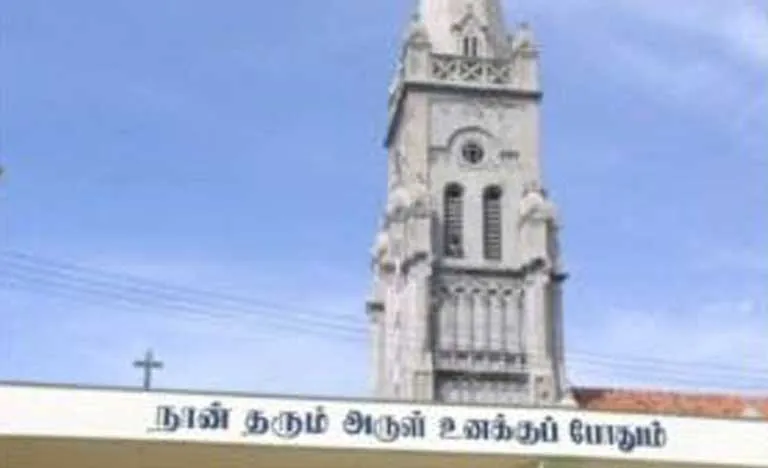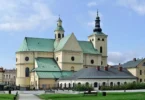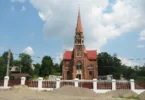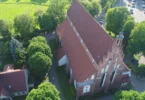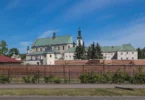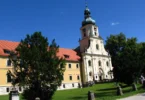Introduction
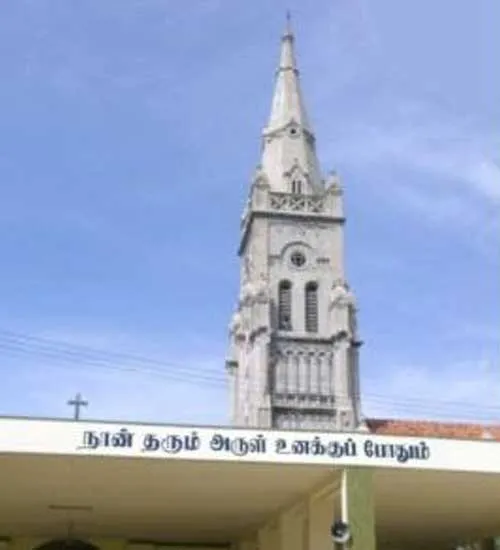
Sacred Heart of Jesus Shrine, Alanthalai, Tuticorin, Tamilnadu, India is one of the oldest villages of the Southern part of the Coramandal area. It is located in the main road from Tutricorin and Kanyakumari. It is nearly 5 Kms south of Tiruchendur, where the famous Hindu temple to Murugan is situated. St. Francis Xavier, the principle patron of missions has visited this place and resided here. He has written two letters from Alanthalai on 5th September 1544.
The neophytes remained normal Christians until the arrival and ministry of St .Francis Xavier in 1542. The Saint had visited Alanthalai a good number of times and wrote two letters on 5/9/1544 to Francis Mansilus camping at Punnaikayal. The place from where he wrote the letters is called SAVERIAR KINARU in Alanthalai. Fr.Henrique Henriques renovated the thatched church in 1558 and named it after St. Peter. Jesuit’s report of 1571 vouch this fact.
In 1849 when this church’s construction was completed it was dedicated to the sacred hearts of both Jesus and mother Mary. Hence this church is called as “Sacred Hearts” .
Alanthalai is well known for the Sacred Heart Shrine since 1928.
On Fridays, the day of the Most Sacred Heart of Jesus, people visit this shrine to participate in the liturgy and special blessing is given to the sick after the mass.
Alanthalai is one of the ancient villages in the pearl fishery coast during the middle of Sixteenth century. We are already aware of how Paravars were converted to Christianity by Portuguese followed by the strengthening in the faith by the arrival of St. Francis Xavier in these coastal regions including Alanthalai.
The Portuguese advised the Paravars scattered around 30 villages to settle in leading Pearl Fishery Ports so that the violence unleashed by the Arabs could be handled. Thus the Great Alanthalai became one of the Seven Pearl Fishery Ports including Tuticorin, Kayalpattinam etc. for the Portuguese.
History of Sacred Heart of Jesus Shrine, Alanthalai
A thatched church was constructed at Alanthalai by St. Francis Xavier was later renovated during 1558 by Jesuit Fr. Henriques (who built many churches in the coastal region during this time) and it was named after St. Peter. This fact has been established in a Jesuit’s report in 1571. The place in Alanthalai from where St. Francis Xavier wrote the letters to Rome and others is called “SAVERIAR KINARU” and it still exists there.
Alanthalai is one of the ancient villages in the pearl fishery coast in the middle of the sixteenth century. St. Francis Xavier stayed in this village and wrote at least two letters on the 5 th of September 1544 to Francis Mansilus camping at Punnaikayal. We come to know that 1178 catholics lived here in 1644 and among them 140 were children The parish priest planned and started the work to build a church of St. Peter . But, due to several reasons he could not proceed with the work. Meanwhile St. Antonya’s church was built. Finally Fr. Chansess completed the work of St. Petera’s church in 1712. From 1708 to 1709 both Alanthalai and Veerapandianpattanam was governed by Fr. John Meinot.
Ministries in Alanthalai were in the hands of Jesuit Priests till 1774. Later Pope Clement XIV “de-recognised” or “suppressed” the Jesuits and the administration of this Parish went to Goan Priests till 1838. The Jesuits took over the parish again when the “Society of Jesus” (Jesuits) was restored by Pope Gregory XVI in 1832. Owing to shortage of Priests the Alanthalai Parish was functioning as a substation of Virapandianpatinam parish from 1800 to 1894.
However, Alanthalai was bifurcated from Veerapandianpattanam and the first Tamil speaking priest Fr. Constance Thairiyam became its parish priest. Internal turbulence occurred in this village between 1915 to 1918. But, when Fr. Ambrose Missier took charge, foundation was laid for the present church on the 29 th of June 1929. In his time itself Sacred Heart Grotto was built as a memorial of the peace that was achieved in the village. In 1929 Fr. Soosainather was made the parish priest. In his time the Nuncio Most. Rev. Leo Petercearcals consecrated the church in 1938.
History of Grotto (Keby in Tamil) of Sacred Heart
The early 20th century saw dissension in the village and it led to a few leaving the Catholic church. When the dissension took place (1920) the first Latin rite parish priest Rev.Fr.Ambrose Missier came and he spread and inculcated the Devotion to the Sacred Heart of Jesus with the installation of His holy picture. After this many of the Paravars who left Catholic church retraced their path and rejoined the Catholic church. This miracle marked the foundation for the construction of the Keby (Holy Grotto).
In the meanwhile, Tuticorin was elevated to the status of Diocese in 1923 and the first Latin rite Bishop G.F.T.Roche S.J. was installed. When the Bishop was heading to Manapad from Tuticorin, the villagers gave a warm reception to him. Nevertheless a few who still did not rejoin the Catholic church stood away from the faithful. Seeing them the Bishop said
“I also pray for my brothers who are standing away from here so that the blessings of Almighty God may continue to increase on them also”.
This sincere prayer of the Bishop melted the hearts of those who stood away from the receiving crowd and they also returned to Catholic church.
In 1926 as a recognition of this peace that had dawned in the village, Fr. Ambrose Missier vowed to build a grotto (Keby) depicting the scene of “Jesus Christ appearing to Mary Magdalene”.
The foundation stone was laid in 1926 by Fr.Missier. An artist from Manapad painted the scene of Jesus Christ appearing to Mary Magdalene and a sculptor from Idaikattur Mr. Manuel Pillai carved the Grotto. On 30th June, 1928 his Grace Bishop G.F.T.Roche blessed the Grotto (Keby).
Why is it called "Chinna Koil” ?
Till independence there were only 2 parishes that existed in Tuticorin – “Our Lady of Snows” and “Sacred Hearts”. Sacred Hearts cathedral is much bigger than Our Lady of Snows Basilica, but ironically this church is called as the “Chinna Koil” (meaning small church in Tamil). Snows church is called as the “Periya Koil” (big church in Tamil). The naming came because Snows was built much ahead of Sacred Hearts and it received a wider recognition from the people. In order to distinguish between these 2 popular churches people started calling the earlier one (Snows church) as big church and the latter one (Sacred Hearts) as small church. In no way this term depicts the size of the churches.
Though Tuticorin town has several churches, Snows church and Sacred Hearts church are the 2 most famous. We should note that the first church is elevated to the status of “Basilica” and the second to the status of “Cathedral” by Roman Catholicism.
On 12th June 1923 when Tuticorin diocese was created, Sacred Hearts church was elevated to the status of “Cathedral”. This church became the headquarters for Tuticorin diocese and in 1923 Rev. Roche became the first Bishop for this diocese. Subsequently Sacred Hearts cathedral was established as the Bishop House of the diocese.
Architecture - Church’s Construction
In 1839 when Tuticorin was controlled by Madurai mission (Jesuits from France) the local villagers supported the establishment of Goa Mission (Portuguese mission). For this the head of villages ousted the Jesuit priest Fr. Martin from Our Lady of Snows and handed it to the Goa mission. Since Jesuit priests in Madurai mission lost control over the snows church they wanted to construct a separate church in Tuticorin. After waiting for nearly 9 years the Jesuit priests in Madurai decided to construct a church in Tuticorin. The construction of Chinna Koil started in 1848 under the supervision of Jesuit priests from Madurai.
The construction began in 1848 by Fr. Piccinelli and a small church was blessed open on January 5th of 1849. Rev. Fr. Kanos who was the bishop of Madurai Apostolic Province blessed the new church. Construction of a bigger church was going on simultaneously around this small church which was completed after 15 years in 1864.
After 45 years in 1909 the church’s side wings were extended. The towers which we see in the front were built in 1948 and were considered to be a great achievement during those times. Limestone was used to build these towers which were churned by the bulls during those times. Today this church stands as one of the finest French architectural church in India.
Tamil Nadu has several churches which need to be visited. Portuguese and French have imprinted their beautiful architecture. By looking at some of the old churches we can distinguish if it follows the French or Portuguese architecture.
Special Features of the Shrine
- Inner wooden architecture and paintings in stained glasses reflect the French architecture.
- There is a statue of Jesus Christ in the cross wherein one of his hands embraces St. Francis of Assisi.
- Finest wooden crafts, not just in the altar but everywhere around the church.
- The Eucharistic tabernacle is designed as a Pearl, symbolizing Pearly city Tuticorin.
- The inside of central dome has paintings depicting Jesus Christ, Mother Mary, Angels etc.
- When you get time kindly visit these churches around coastal Tamilnadu. Each church has it’s own architectural speciality..
Other Facilities :
- There is a Chapel for Silent Prayers.
- There is a Depot where sacred things are sold.
- There are rooms available for the pilgrims to stay.
Feast Day – Last Friday of August
Annual Feast of this Shrine is observed during the Last Friday of August.
Mass Time
Weekdays
Fridays
Every First Fridays
Sundays
Contact Info
Sacred Heart of Jesus Shrine,
Alanthalai – 628 219, Tiruchendur,
Tuticorin District, Tamilnadu, India
Phone No.
Tel : 04639 – 245 306
Accommodations
Connectivity
Sacred Heart of Jesus Shrine, Alanthalai, Tuticorin, Tamilnadu, India is 4 kms by road from Tiruchendur towards Kanyakumari. Alanthalai is a coastal village. This Shrine is well connected with Bus Station, Railway Station and Airport facilities rest of the country.
Airways
Tuticorin Domestic Airport, Tamilnadu, which is (43 Kms) from Sacred Heart of Jesus Shrine, Alanthalai.
Railways
The nearest railway station is Tuticorin Railway Station which is just (5.3 Kms) from Sacred Heart of Jesus Shrine, Alanthalai.
Roadways
The nearest is Tuticorin Bus Station which is (5.4 Kms) from Sacred Heart of Jesus Shrine, Alanthalai.

